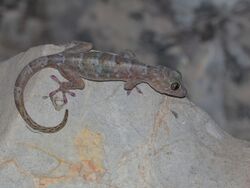Biology:Lauhachinda's cave gecko
| Lauhachinda’s cave gecko | |
|---|---|

| |
| Scientific classification | |
| Domain: | Eukaryota |
| Kingdom: | Animalia |
| Phylum: | Chordata |
| Class: | Reptilia |
| Order: | Squamata |
| Family: | Gekkonidae |
| Genus: | Gekko |
| Species: | G. lauhachindai
|
| Binomial name | |
| Gekko lauhachindai Panitvong, Sumontha, Konlek & Kunya, 2010
| |
| Synonyms[2] | |
| |
Lauhachinda's cave gecko (Gekko lauhachindai) is an endangered species of lizard in the family Gekkonidae. The species is endemic to Thailand.[2]
Etymology
The specific name, lauhachindai, is in honor of Thai herpetologist Virayuth Lauhachinda.[2]
Geographic range
G. lauhachindai is found in karst regions of central Thailand.[2][3]
Description
Medium-sized for its genus, G. lauhachindai as an adult has a snout-to-vent length over 10 cm (3.9 in). In life, the iris of the eye may be entirely coppery brown, or it may be greenish gray with coppery brown around the margins of the pupil.[2]
G. lauhachindai is distinct from its congeners by its size, slender body shape, a relatively smaller snout-to-eye-diameter ratio, and the presence of large, bright whitish dorsal spots and horizontal bars.[4]
Behavior
Little is known regarding the behavioral patterns of G. lauhachindai. Lauhachinda's cave gecko feeds primarily on insects. Predators of this species include several species of snakes and domesticated cats. This gecko is thought to lay eggs in the dry months.[4]
Habitat
The preferred natural habitat of G. lauhachindai is dry caves.[1] Its presence is restricted to limestone caves and in close proximity to the entrances of such caves. This habitat is shared with other members of Gekkonidae such as the tokay gecko G. gecko and Siamese green-eyed gecko G. siamensis.[3][4]
References
- ↑ 1.0 1.1 Sumontha, M.; Cota, M. (2018). "Gekko lauhachindai". IUCN Red List of Threatened Species 2018: e.T104717581A104718921. doi:10.2305/IUCN.UK.2018-2.RLTS.T104717581A104718921.en. https://www.iucnredlist.org/species/104717581/104718921. Retrieved 18 November 2021.
- ↑ 2.0 2.1 2.2 2.3 2.4 Gekko lauhachindai at the Reptarium.cz Reptile Database
- ↑ 3.0 3.1 Rujirawan, Attapol; Fong, Jonathan J.; Ampai, Natee; Yodthong, Siriporn; Termprayoon, Korkhwan; Aowphol, Anchalee (2019-03-12). "A new karst-dwelling gecko of the Gekko petricolus group (Reptilia: Gekkonidae) from Phitsanulok Province, central Thailand". Journal of Natural History 53 (9-10): 557–576. doi:10.1080/00222933.2019.1597937. ISSN 0022-2933. https://doi.org/10.1080/00222933.2019.1597937.
- ↑ 4.0 4.1 4.2 Meesook, Worawitoo; Sumontha, Montri; Donbundit, Nattasuda; Pauwels, Oliver S. G. (2021-05-11). "A new cave-dwelling Gekko (Gekko) from Lopburi Province, central Thailand (Squamata, Gekkonidae)". Zootaxa 4969 (2). doi:10.11646/zootaxa.4969.2.5. ISSN 1175-5334. http://dx.doi.org/10.11646/zootaxa.4969.2.5.
Wikidata ☰ Q3100216 entry
 |


